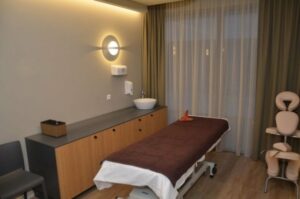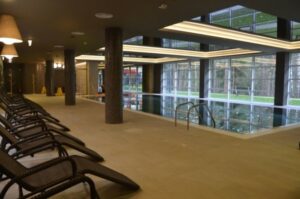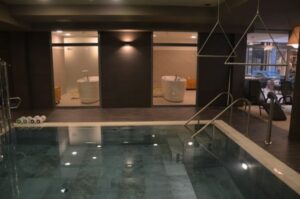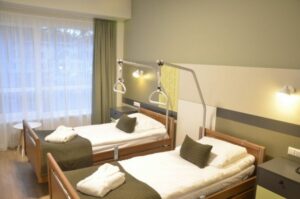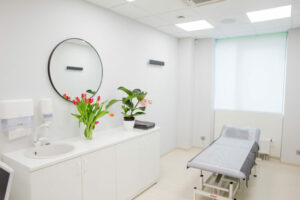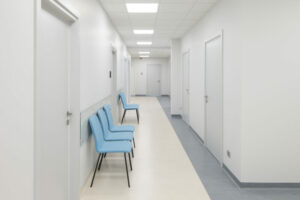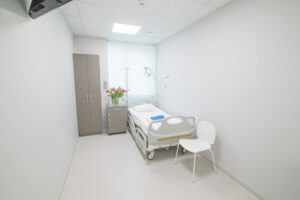Total hip replacement abroad: Lithuania Canada draft
Price in USD
Price in CAD
All-inclusive prices:
- Hip replacement surgery – 4.400 $
- Hip implants – from 3.200 $
- Rehabilitation after surgery – from 155 $ per day
Package prices:
- Package 1 (surgery + implant + 7 days rehabilitation) – from 8.900 $
- Package 2 (surgery + implant + 14 days rehabilitation) – from 9.980 $
Free choice of newest generation implants: Zimmer Biomet, Smith & Nephew and other.
Be sure that there are no hidden charges so that you do not end up paying more than expected. What is included:
- consultation with the surgeon
- consultation with the anesthesiologist
- necessary health tests
- surgery
- implant
- anaesthesia
- hospitalisation
- 24/7 personal assistance during your stay
- transfers to / from the airport, hotel and clinic
- all documents translated in English
The clinic uses Zimmer Biomet, Smith & Nephew and other highest quality implants. The implant option is discussed in detail once the surgeon reviews your individual case.
You can reach Lithuania from any USA or Canada district. Below you can see flight options for the moment from a few USA and Canada cities to Vilnius or Kaunas.
Canada:
- The flights from Toronto take about 11 hours with 1 stop, and prices start from 900 $
- The flights from Edmonton take about 16 hours with 2 stops, and prices start from 800 $
- The flights from Montreal take about 15 hours with 1 stop, and prices start from 800 $
USA:
- The flights from New York take about 14 hours with 2 stops, and prices start from 400 $
- The flights from Chicago take about 16 hours with 2 stops, and prices start from 400 $
- The flights from Los Angeles take about 18 hours with 1 stop, and prices start from 500 $
- The flights from Miami take about 17 hours with 2 stops, and prices start from 500 $
All-inclusive prices:
- Hip replacement surgery – 5.480 C$
- Hip implants – from 3.960 C$
- Rehabilitation after surgery – from 190 C$ per day
Package prices:
- Package 1 (surgery + implant + 7 days rehabilitation) – from 11.100 C$
- Package 2 (surgery + implant + 14 days rehabilitation) – from 12.500 C$
Free choice of newest generation implants: Zimmer Biomet, Smith & Nephew and other.
Be sure that there are no hidden charges so that you do not end up paying more than expected. What is included:
- consultation with the surgeon
- consultation with the anesthesiologist
- necessary health tests
- surgery
- implant
- anaesthesia
- hospitalisation
- 24/7 personal assistance during your stay
- transfers to / from the airport, hotel and clinic
- all documents translated in English
The clinic uses Zimmer Biomet, Smith & Nephew and other highest quality implants. The implant option is discussed in detail once the surgeon reviews your individual case.
You can reach Lithuania from any USA or Canada district. Below you can see flight options for the moment from a few USA and Canada cities to Vilnius or Kaunas.
Canada:
- The flights from Toronto take about 11 hours with 1 stop, and prices start from C$ 1100
- The flights from Edmonton take about 16 hours with 2 stops, and prices start from C$ 1000
- The flights from Montreal take about 15 hours with 1 stop, and prices start from C$ 1000
USA:
- The flights from New York take about 14 hours with 2 stops, and prices start from C$ 500
- The flights from Chicago take about 16 hours with 2 stops, and prices start from C$ 500
- The flights from Los Angeles take about 18 hours with 1 stop, and prices start from C$ 600
- The flights from Miami take about 17 hours with 2 stops, and prices start from C$ 600
Testimonials





Reviews & Facebook group
Our patients and clinic in the media
Clinic videos
Only we can offer:
One of the most experienced orthopaedic surgeons in Europe. More than 3.500 joint replacement surgeries were performed by our surgeon to this date – a figure that no other surgeon or clinic in the region can match.
More than 150 scientific articles co-authored by our surgeon and over 50 publications in different medical journals. You can read the most recent one here.
More than 188 positive reviews from our happy clients from all over the world. Accept the challenge and read them all here!
Nordorthopaedics Center Of Excellence

Flights to Lithuania







Experienced hip and knee surgeon
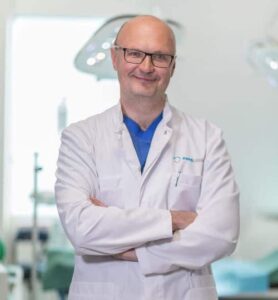
- More than 15+ years of working experience
- Over 3.500 joint replacement surgeries performed
- Fluent in English
- President of Lithuanian Society of Orthopaedics and Traumatology
- Training abroad: Sweden, Switzerland, Germany, Austria
- Read more
Rehabilitation packages
The rehabilitation centre is located at a SPA resort town called Druskininkai. It is equipped with modern facilities. The professionals there have years of experience working with people after various surgeries and injuries.
Rehabilitation in Lithuania – from $ 155 / C$ 190 per day
- personalized rehabilitation course
- room with TV and private bathroom
- three meals a day
- all medication needed
- transportation to/from the rehabilitation centre
An individual rehabilitation program is prepared for each patient depending on the type of surgery, general patient‘s well-being, health status and other factors.
Our rehabilitation centre
Our clinic
What sets us apart from other clinics?
Our clinic works with highly professional and educated surgeons. They have 10-20 years of experience in the field of orthopaedic surgery. They each perform 500 surgeries per year. Moreover, our surgeons are members of various prestigious surgical societies both Lithuanian and international. Our joint replacement surgeon S. Tarasevicius is an author of 150 scientific publications in different medical journals. Find more information about our surgeons here.
Our clinic works according to the highest standards set by the European Union. This helps to guarantee the quality of medical service.
During your entire stay in Lithuania you will receive personal care as well as transport to and from the clinic, hotel, and airport. You will not have to worry about a thing. You will be assisted from the moment of plane landing in Vilnius or Kaunas airport till your departure.
We have no waiting line so we can schedule your surgery as soon as you are ready to do so.
Everyone in our clinic speaks English, including nurses, assistants and the surgeon.
2-3 hour regular flights operate from all main airports in the UK & Ireland. Lithuania is closer than you thought. You can find the list of direct flights here. Please note that airlines constantly add new flights and new destinations, therefore feel free to contact us if you need help choosing the flight that suits you best.
Lithuania has been a part of the EU and NATO since 2004. Lithuania has one of the fastest growing economies in the whole region and the second fastest internet speed in the world. Lithuanian medical schools have trained many medical professionals who are highly appreciated and employed by many foreign hospitals, among which hospitals in the UK. Our clinic works according to the highest standards set to the medical institutions by the European Union.
Our clinic uses implants based on their performance in international registries.
Our clinic is open and operates in accordance with all safety requirements. As of June 1, fully vaccinated U.S. and Canadian citizens are allowed to enter Lithuania and are not required to quarantine. All the procedures are implemented as usual. You can read about the latest COVID-19 updates here.
What is a hip replacement?
A hip replacement, also known as a total hip arthroplasty, is an orthopaedic surgery performed in order to restore hip motion and relieve pain of the hip joint. During this surgery, a dysfunctional hip joint is changed into a prosthetic implant.
A hip joint consists of a round femur head which tightly fits into a socket (acetabulum). Normally surfaces of the acetabulum, as well as the femur head, are both covered with a thick layer of cartilage. It cushions the bones where they meet to form the joint. However, due to various medical conditions, such as osteoarthritis, rheumatoid arthritis, or osteonecrosis, hip cartilage is damaged and can no longer perform its function. Note that hip replacement surgery is performed when all other treatments have not provided enough pain relief.
A hip replacement surgery is done under epidural anaesthesia and deep sedation.
- Firstly, a surgeon makes an incision along the side of the hip and divides and repositions the muscles that cover the joint.
- Then a socket (acetabulum) is prepared by removing damaged cartilage and bone spurs.
- Depending on the implant and technique, a surgeon may use bone cement to implant and tightly anchor a metal socket in the acetabulum.
- A femoral part of the joint requires preparation as well. The surgeon excises the head of the femur and replaces it with a stem implant as well as a round head implant which are inserted into the femur bone.
- Finally, implants of the socket and the head are both joined and secured together to form a new functional joint.
FAQ about hip replacement with our surgeon
More FAQ videos from our surgeon:
Watch full list of interview sessions on our Youtube channel.
Preparing for a hip replacement surgery
There are several important things a potential patient needs to consider as a hip replacement surgery approaches.
Firstly an orthopaedic surgeon should be consulted. A thorough assessment of the patient’s health will be carried out and a detailed plant of the treatment arranged.
Approximately a month before the procedure a patient is advised a muscle strengthening exercise routine. It is essential to be physically prepared for the postoperative period, therefore, the patient can take up specific exercises that improve the strength of the muscles in the upper leg, gluteal region, hips, and arms.
The medical team should be informed about the current intake of any medication. Patients are usually recommended not to take certain blood-thinning drugs (e.g. aspirin) or non-steroidal anti-inflammatory drugs (e.g. ibuprofen). Your doctor will give precise instructions about taking medication before the surgery.
For a successful surgery and recovery, it is recommended for the patient takes certain vitamins, like vitamin D, vitamin C, and vitamin A, as well as certain minerals, such as calcium, zinc, and iron. Sufficient vitamin and mineral intake is important for the formation of bones and connective tissue. Bear in mind that following a healthy diet is essential, too. Meals should contain enough protein, non-starchy vegetables, and grains.
What are the eligibility criteria for a hip replacement surgery?
There are no age-related requirements. Even though most of replacement surgeries are performed on patients between 60 and 80 years of age, younger patients can also be eligible.
Tissue-preserving technique
A tissue-preserving hip replacement, also known as minimally invasive total hip arthroplasty (THA), is a surgical technique which is getting increasingly popular because of a shorter hospital stay and decreased rehabilitation time. It is similar to a traditional hip replacement surgery, however, it is designed to preserve muscle and connective tissue around the hip.
A tissue-preserving full hip replacement is different from a traditional full hip replacement because a much shorter incision of about 13 cm is made as compared to approximately 25 cm in traditional surgery. Moreover, muscles and ligaments are detached to a lesser extent than in traditional hip replacement surgery. Special surgical tools and techniques are used to access hip joint without damaging the surrounding tissues. The implants are the same as in traditional hip replacement.
Note that not every patient is recommended a tissue-preserving hip replacement surgery. This procedure is usually offered to patients who are younger and have a better physical form. One’s eligibility for this type of hip replacement surgery will be evaluated during a private consultation with a doctor.
What to expect after hip replacement surgery?
The surgery will take approximately 2 hours. After the surgery, you will be moved to a recovery room as you recover from deep sedation. Once you are alert, you may feel some discomfort in the hip area. After waking up from deep sedation some patients may feel the need to clear their lungs by coughing excessively which is completely normal. Patients will have to take pain-relieving drugs or will have them administered through an intravenous catheter. A drain tube will probably be placed inside the hip at the incision site. On the first day, patients are usually allowed to drink and consume foods.
Patients usually spend approximately 2 days at the hospital. After the first day, most of them can sit up on the edge of the bed and stand. On the second day, patients can walk slowly using crutches.
On day two or three most patients will start physical therapy. Patients are recommended to sleep on the healthy hip with a pillow between the legs to position the operated hip comfortably. Make sure to have assistance at home, which is necessary for the first few weeks. The patients are recommended to refrain from housework and other activities, such as gardening.
The importance of physical therapy
Patients are likely to begin doing light recovery exercises the next day after surgery. Later on, patients will be introduced to a special exercise routine which helps to regain muscle strength and mobility much faster. Even though moving or exercising might feel uncomfortable at first, actively participating in physical therapy is crucial for a successful healing of the muscles and reduced overall recovery time. A physiotherapist will adapt a recovery program and the difficulty of the exercises depending on individual progress. At the beginning of the post-operative period, patients are recommended to exercise for 20 minutes 3 times per day. More details on specific exercises will be given during one’s stay at the hospital and rehabilitation centre.
How to reduce risks of flying after a hip replacement surgery?
Flying right after a surgery may increase the risk of deep vein thrombosis (DVT). DVT is a formation of a blood clot within a deep vein in the body, usually in the legs. A blood clot blocks blood flow and in extremely rare cases can travel to the lungs and cause pulmonary embolism. Prolonged sitting time may provoke clot formation, therefore, it is essential to know how to reduce the risks of travelling.
- In order to prevent any complications, patients are advised to wear compression stockings, especially during a flight which is longer than 4 hours. Compression socks tightly compresses the legs, reducing vein diameter, and therefore, increasing venous blood flow velocity and valve effectiveness.
- Walking whenever possible and doing anti-DVT exercises (foot pumps, ankle circles, leg lifts, and knee pull-ins) will lower DVT risk too.
- A physician will prescribe blood-thinning medication as well.
- The patient should drink plenty of water and avoid consuming alcohol.
Wound care
After a hip replacement is completed, the incision will be stapled and the wound dressings applied. A patient will most likely have a drain tube placed inside the wound and exiting from the bottom end of the dressing. A drain tube prevents serous fluids form collecting at the incision site. Most people have their drainage tube removed before they start walking. Staples should be removed after 10 to 14 days.
Note that the patient should not shower for the first three days. From then on showering is allowed, however, a wound dressing should not be scrubbed and damaged in any way. Bathing and hot tubs should be avoided for the whole recovery period, i.e. until the wound is completely dry without scabs and the staples have been removed.
When recovering at home the patient will need to change the bandages themselves. A wound dressing may need to be changed every day if a physician advised to do so. In order to change the bandage correctly, hands need to be washed well before and after removing an old dressing and a new dressing kept sterile right until placing it over the incision site. The patient will be advised on detailed measurements and types of bandages during their hospital stay.
Driving after a surgery
Patients are not allowed to drive for at least 6 weeks post-surgery, which is subject to surgeon’s advice. It may be tricky to get in and out of the car, therefore, it is best to have assistance until you feel comfortable driving alone again. It is important to practice applying the brake quickly and forcefully as well as slowly as may be required in particular situations. Bear in mind that some pain relieving medications can have a sedative effect and should not be taken before driving.
Physical activity after surgery
Right after the surgery, you will be able to walk, however, it might feel quite uncomfortable. Since you will have to use a cane, walker, or crutches, arrange the furniture at home so that it is not difficult to move around. Avoid the stairs for the first few weeks. Therefore, if your bedroom is located on the upper floor, you might need to consider sleeping in a room that does not require you to walk up and down.
Patients will be provided with a special exercise routine that focuses mainly on strengthening muscles in the hips and upper legs. Bear in mind that walking, although highly beneficial, is not a substitute for the exercises.
Being physically active is a crucial part of a successful recovery. Patients are encouraged to return to an active lifestyle around three months after surgery. Mild physical activities like swimming, golfing or cycling will not only aid in the recovery of your joint but will also positively affect your general health. Highly active sports like running or skiing should be avoided.
Send us your enquiry

